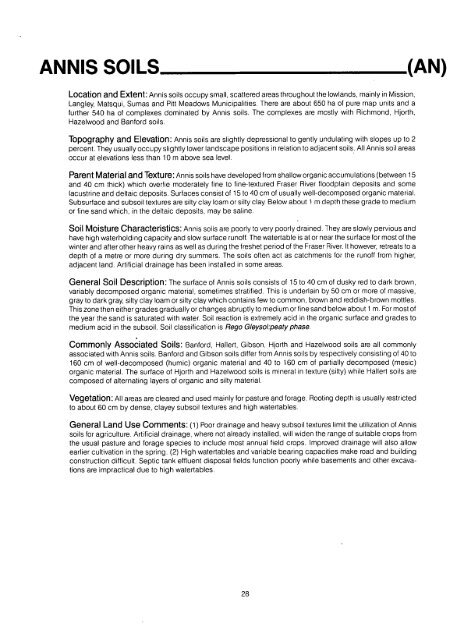Soils of the - Agriculture and Agri-Food Canada
Soils of the - Agriculture and Agri-Food Canada
Soils of the - Agriculture and Agri-Food Canada
You also want an ePaper? Increase the reach of your titles
YUMPU automatically turns print PDFs into web optimized ePapers that Google loves.
ANNIS SOILS (AN)<br />
Location <strong>and</strong> Extent : Annis soils occupy small, scattered areas throughout <strong>the</strong> lowl<strong>and</strong>s, mainly in Mission ,<br />
Langley, Matsqui, Sumas <strong>and</strong> Pitt Meadows Municipalities . There are about 650 ha <strong>of</strong> pure map units <strong>and</strong> a<br />
fur<strong>the</strong>r 540 ha <strong>of</strong> complexes dominated by Annis soils . The complexes are mostly with Richmond, Hjorth ,<br />
Hazelwood <strong>and</strong> Banford soils .<br />
Topography <strong>and</strong> Elevation : Annis soils are slightly depressional to gently undulating with slopes up to 2<br />
percent . They usually occupy slightly lower l<strong>and</strong>scape positions in relation to adjacent soil s: All Annis soil area s<br />
occur at elevations less than 10 m above sea level .<br />
Parent Material <strong>and</strong> Texture : Annis soils have developed from shallow organic accumulations (between 1 5<br />
<strong>and</strong> 40 cm thick) which overlie moderately fine to fine-textured Fraser River floodplain deposits <strong>and</strong> som e<br />
lacustrine <strong>and</strong> deltaic deposits . Surfaces consist <strong>of</strong> 15 to 40 cm <strong>of</strong> usually well-decomposed organic material .<br />
Subsurface <strong>and</strong> subsoil textures are silty clay loam or silty clay . Below about 1 m depth <strong>the</strong>se grade to mediu m<br />
or fine s<strong>and</strong> which, in <strong>the</strong> deltaic deposits, may be saline .<br />
Soil Moisture Characteristics : Annis soils are poorly to very poorly drained . They are slowly pervious an d<br />
have high waterholding capacity <strong>and</strong> slow surface run<strong>of</strong>f . The watertable is at or near <strong>the</strong> surface for most <strong>of</strong> th e<br />
winter <strong>and</strong> after o<strong>the</strong>r heavy rains as well as during <strong>the</strong> freshet period <strong>of</strong> <strong>the</strong> Fraser River . It however, retreats to a<br />
depth <strong>of</strong> a metre or more during dry summers . The soils <strong>of</strong>ten act as catchments for <strong>the</strong> run<strong>of</strong>f from higher ,<br />
adjacent l<strong>and</strong> . Artificial drainage has been installed in some areas .<br />
General Soil Description : The surface <strong>of</strong> Annis soils consists <strong>of</strong> 15 to 40 cm <strong>of</strong> dusky red to dark brown ,<br />
variably decomposed organic material, sometimes stratified . This is underlain by 50 cm or more <strong>of</strong> massive ,<br />
gray to dark gray, silty clay loam or silty clay which contains few to common, brown <strong>and</strong> reddish-brown mottles .<br />
This zone <strong>the</strong>n ei<strong>the</strong>r grades gradually or changes abruptly to medium or fine s<strong>and</strong> below about 1 m . For most <strong>of</strong><br />
<strong>the</strong> year <strong>the</strong> s<strong>and</strong> is saturated with water. Soil reaction is extremely acid in <strong>the</strong> organic surface <strong>and</strong> grades t o<br />
medium acid in <strong>the</strong> subsoil . Soil classification is Rego Gleysol:peaty phase .<br />
Commonly Associated <strong>Soils</strong> : Banford, Hallert, Gibson, Hjorth <strong>and</strong> Hazelwood soils are all commonl y<br />
associated with Annis soils . Banford <strong>and</strong> Gibson soils differ from Annis soils by respectively consisting <strong>of</strong> 40 t o<br />
160 cm <strong>of</strong> well-decomposed (humic) organic material <strong>and</strong> 40 to 160 cm <strong>of</strong> partially decomposed (mesic )<br />
organic material . The surface <strong>of</strong> Hjorth <strong>and</strong> Hazelwood soils is mineral in texture (silty) while Hallert soils ar e<br />
composed <strong>of</strong> alternating layers <strong>of</strong> organic <strong>and</strong> silty material .<br />
Vegetation : All areas are cleared <strong>and</strong> used mainly for pasture <strong>and</strong> forage . Rooting depth is usually restricte d<br />
to about 60 cm by dense, clayey subsoil textures <strong>and</strong> high watertables .<br />
General L<strong>and</strong> Use Comments : (1) Poor drainage <strong>and</strong> heavy subsoil textures limit <strong>the</strong> utilization <strong>of</strong> Anni s<br />
soils for agriculture . Artificial drainage, where not already installed, will widen <strong>the</strong> range <strong>of</strong> suitable crops fro m<br />
<strong>the</strong> usual pasture <strong>and</strong> forage species to include most annual field crops . Improved drainage will also allo w<br />
earlier cultivation in <strong>the</strong> spring . (2) High watertables <strong>and</strong> variable bearing capacities make road <strong>and</strong> buildin g<br />
construction difficult. Septic tank effluent disposal fields function poorly while basements <strong>and</strong> o<strong>the</strong>r excavations<br />
are impractical due to high watertables .<br />
28

















